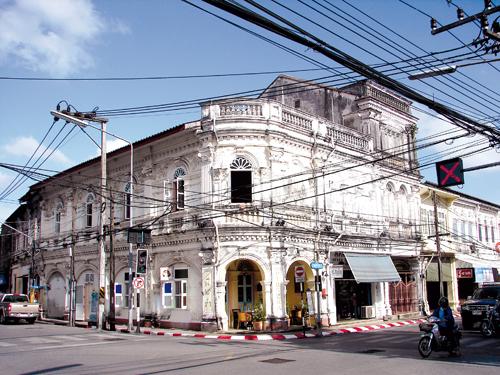Preserving Phuket’s old streets

PHUKET: As sprawl and congestion take full-hold of our island, Phuket city municipality planners and engineers strive, yet struggle, to preserve the last remnants of urban historical heritage, yet continue to face a number of obstacles obstructing the way ahead.
Indeed, the narrow streets in Phuket’s Old Town district are currently undergoing a drastic makeover. The electrical wires that currently hang precariously up and down the streets are on the immediate list to soon be moved underground.
Phuket Municipality, along with the Provincial Electrical Authority (PEA), ToT Pcl and CAT Telecom Pcl, have undertaken the project to help restore the Old Town’s historical charm, mostly in an attempt to maintain, if not increase tourism appeal.
The first phase of the city beautification initiative took place on Thalang Road and Soi Romanee with work finishing over a year ago. The second phase has already started on sections of Krabi, Dibuk, Phuket and Thepkrasattri Roads.
However, Mr Kriangsak Chuchatpong Phuket city municipality director of engineering told the Gazette that construction on Yaowarat road, which is in the second phase, has stalled.
“We cannot install [tap into the] main power [grid] underground [in that area], and have [instead] been considering two [access or routing] points, around Soi Soon Utit and Phang Nga road… We’re also waiting for the decision [approval] from the governor and contractor.
“The [underground grid] project will run from the junction of Yaowarat and Dibuk roads, to the fountain traffic circle, and we expect to proceed in October, 2013.” Meanwhile, the third phase, which has no set start date yet, will cover parts of Phang Nga, Rassada, Yaowarat and Dibuk Roads.
Beyond these efforts to bury cables, we need not lose sight of the greater picture. Treading steadily along the path of city beautification, planners can also look for inspiration in other island based cities.
Dr Sopon Pornchokchai, president of Agency for Real Estate Affairs (AREA), recently conducted research on the narrow streets found in cities in Japan, and made comparison to those in Bangkok and elsewhere in Thailand.
Dr Sophon believes that a city should maintain and encourage the improvement (of aesthetic appeal) along narrow streets in old city centers. He noted that the narrow streets in Japan are very similar to the ones in Thailand, especially Pahurat, Bang Lampoo, Sampang and Yaowarat in Bangkok.
But, unlike “Old urban Japan”, he said the old center of Bangkok tends to be ignored, while improvements to infrastructure and development ideas tend to focus around newer areas such as, Silom, Ratchada Pisek, Rama 3, Bang Na, Srinaka-rin and Pin Klao.
These areas of Bangkok have followed a more modern western design with wider streets.
Bangkok is a city that is expanding outwards from its old center and this development destroys the surrounding environment, according to Dr Sophon.
Before the city started sprawling, Bang Mod was the best location to grow oranges and Bang Na was the best area to harvest rice. Now these areas are full of buildings.
Old city centers in Japan are developed to become the commercial hub of the city and high density buildings are built, whereas in Bangkok people move away from the old center instead of trying to develop it.
And as Phuket planners and developers continue to compete and contest where the island’s “next center” will be, perhaps it is wise to continue to improve, perfect and build on our existing treasures.
Latest Thailand News
Follow The Thaiger on Google News:
























